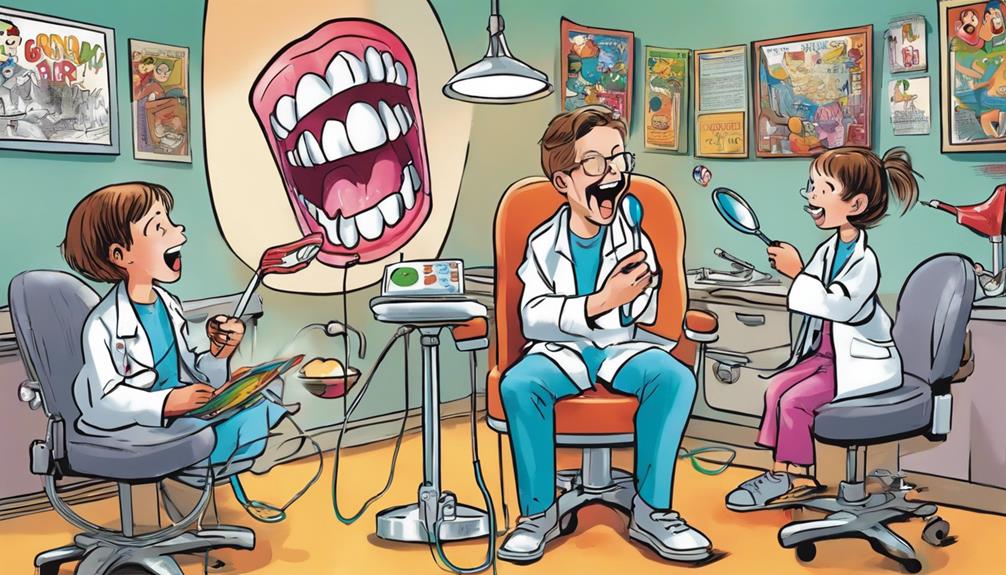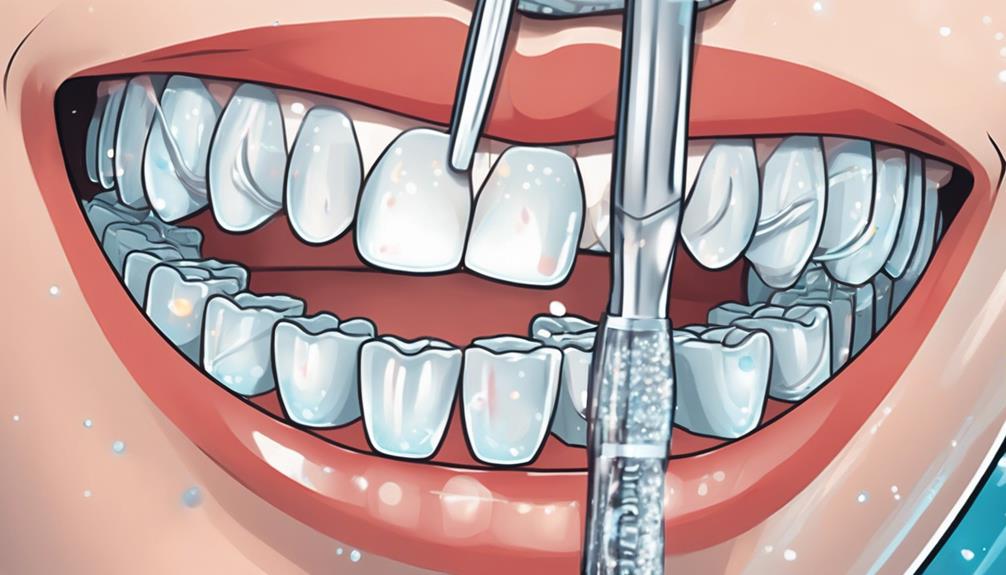To spot early signs of gum disease in kids, watch for swollen or red gums and frequent bleeding during brushing. Persistent bad breath can also indicate underlying issues. If you notice receding gums, it's a sign of more advanced gum disease. Be proactive by encouraging good oral hygiene habits, like brushing twice a day and flossing regularly. Regular dental check-ups are essential for early detection and intervention. Staying attentive to these symptoms can prevent complications down the road and guarantee your child's gum health. There's plenty more you can do to support their smile and overall well-being. Help your child understand the importance of maintaining their dental health by teaching them the proper techniques for brushing and flossing. Encourage them to limit their intake of sugary snacks and drinks, as these can contribute to the development of gum disease. Remember, a balanced diet plays a significant role in overall dental health. By following these dental health tips for kids, you can set them on the path to a lifetime of healthy smiles.
Key Takeaways
- Look for swollen, red gums, which indicate inflammation and potential gum disease in children.
- Frequent bleeding during brushing or flossing is a significant warning sign of gum issues.
- Persistent bad breath may signal underlying gum health problems that need attention.
- Monitor for receding gums, as this can indicate advanced stages of gum disease.
Importance of Gum Health

Maintaining healthy gums is essential for your child's overall oral health and can prevent serious issues down the line. Healthy gums support teeth and guard against infections that could lead to tooth loss. By focusing on gum health, you're not just promoting a bright smile; you're also safeguarding your child's well-being.
Being aware of the early signs of gum disease, like swollen gums or redness, is crucial. Regular dental visits help catch these issues before they escalate. During check-ups, dentists can assess plaque buildup and recommend necessary treatments.
Encouraging good oral hygiene habits at home, such as brushing and flossing, plays a critical role in preventing gum disease. Make it a routine to teach your child the importance of cleaning their teeth and gums properly.
When children understand that maintaining healthy gums can impact their ability to eat, speak, and smile confidently, they're more likely to embrace these practices. Taking proactive steps now will set the foundation for a lifetime of good oral health, ensuring that gum disease remains at bay and that your child enjoys a healthy, happy smile.
Understanding Gum Disease

Gum disease is an infection that affects the tissues supporting your child's teeth, often starting with plaque buildup.
You might notice common symptoms like swollen or bleeding gums, which can signal early problems.
Understanding these signs is essential, as catching gum disease early can prevent serious issues down the line.
Definition of Gum Disease
Understanding gum disease involves recognizing it as an infection that targets the tissues supporting the teeth, primarily caused by plaque buildup and bacterial growth.
In children, the early signs of gum disease often manifest as gingivitis, which is the initial, reversible stage of this condition. If you notice swollen gums or any tenderness, it's important to take action. Good oral hygiene practices like regular brushing and flossing can greatly reduce the risk of gum disease.
Encouraging your child to maintain proper oral hygiene is critical. Make sure they brush their teeth at least twice a day and floss daily. Regular dental exams are also essential for spotting gum disease early. During these visits, a dentist can identify any plaque buildup and inflammation that may indicate the onset of gum disease.
Ignoring the early signs can lead to more severe issues, including receding gums and tooth loss. Being proactive about your child's oral health will help them avoid complications down the road. So, stay vigilant, and make sure your child understands the importance of oral hygiene in preventing gum disease.
Common Symptoms in Children
Kids can show several warning signs of gum disease, making it crucial for parents to recognize symptoms like swollen, red gums and frequent bleeding during brushing. If your child's gums appear swollen or tender, it's a clear sign of inflammation that shouldn't be ignored.
Frequent bleeding during brushing or flossing is another significant indicator of gum disease in children. You might also notice persistent bad breath that doesn't improve despite maintaining good oral hygiene habits. This could signal underlying gum issues that need attention.
Receding gums, where the gum line appears to pull away from the teeth, can indicate advanced stages of gum disease. Changes in gum color and texture are also concerning signs of gum disease that require prompt action.
Additionally, if your child starts to develop loose teeth, especially when combined with other symptoms, it may point to a serious progression of gum disease. By staying vigilant and monitoring these signs of gum disease, you can help guarantee your child maintains a healthy smile and good oral hygiene.
Importance of Early Detection
Early detection of gum disease is essential for safeguarding your child's oral health and preventing more serious complications down the line.
Gum disease often starts with gingivitis, which causes inflammation and bleeding of the gums. If caught early, this can be easily reversed with proper dental care. Ignoring the initial signs can lead to more severe issues, such as periodontitis, which can result in tooth loss and other systemic health problems.
To guarantee a healthy smile for your child, consider these key points:
- Regular check-ups: Schedule dental visits every six months to catch early signs of gum disease.
- Educate on oral hygiene: Teach your child proper dental hygiene practices, including effective brushing and flossing techniques.
- Monitor symptoms: Be observant of any signs of inflammation or bleeding gums during daily cleaning.
Causes of Gum Disease

Poor oral hygiene is the leading cause of gum disease in children, as infrequent brushing and flossing allow plaque and tartar to accumulate. This buildup creates a perfect environment for harmful bacteria to thrive, leading to inflammation and infection.
Additionally, a diet high in sugar can worsen the situation by providing more fuel for these bacteria, increasing the risk of gum disease.
Genetic predisposition can also play a role; some children may be more susceptible to gum disease due to their family history. That's why regular dental check-ups are essential. These visits not only help with early detection but also allow for professional cleaning to remove plaque and tartar that brushing might miss.
Certain medical conditions, like diabetes, can make your child more vulnerable to gum disease, especially if they're on medications that cause dry mouth. This lack of saliva reduces the mouth's natural defense against harmful bacteria, further increasing the risk.
Early Signs to Watch For

Recognizing the early signs of gum disease can help you take timely action to protect your child's oral health. Pay close attention to the following indicators, as they can signal the onset of gum issues like gingivitis:
- Frequent bleeding of the gums during brushing or flossing, which often points to inflammation and irritation.
- Swollen, red, or tender gums, a clear sign that your child may be developing gingivitis.
- Persistent bad breath, even after brushing, that may indicate underlying problems with your child's gums.
It's essential to monitor your child's gum health regularly. If you notice any of these early signs, don't hesitate to consult with a dental professional.
Early intervention can prevent more serious gum disease and protect your child's smile for years to come. Remember, a little vigilance goes a long way in ensuring your child's oral health stays on track!
Steps to Take When Noticed

When you notice signs of gum disease in your child, act quickly to safeguard their oral health. Schedule an appointment with a dentist or periodontist as soon as possible. Early intervention is essential for managing gum disease effectively. During the visit, discuss the condition of your child's gums and any concerns you have.
To support treatment, implement proper oral hygiene practices at home. Confirm your child brushes twice daily with fluoride toothpaste and flosses daily to remove plaque and tartar buildup. These habits can greatly reduce the risk of gum disease progression.
Consider professional dental cleanings, as they're important for removing any plaque and tartar that regular brushing might miss. If your child has been diagnosed with early-stage gingivitis, ask your dentist about scaling and root planing. This deep cleaning procedure can help prevent further complications.
Prevention Strategies for Kids

To keep gum disease at bay, start by establishing a solid dental hygiene routine for your child. Encourage them to brush their teeth twice a day with fluoride toothpaste and to floss daily. This helps remove plaque buildup, a primary cause of gum disease. Additionally, teach them the importance of proper brushing techniques to guarantee all surfaces of their teeth and gums are effectively cleaned.
Here are some effective prevention strategies:
Schedule regular dental check-ups every six months for professional cleanings and early detection of potential gum issues.
Educate your child about the importance of a balanced diet low in sugar, as excessive sugar can increase the risk of gum disease.
Monitor for early signs of gum disease, like redness, swelling, or bleeding during brushing, and seek care promptly if you notice any of these symptoms.
Make flossing a fun activity to encourage consistency, perhaps by using colorful or flavored floss.
Role of Dental Professionals

Dental professionals are essential in spotting early signs of gum disease in kids, ensuring timely interventions that can prevent more serious issues down the line. Pediatric dentists are specifically trained to assess children's gums and provide age-appropriate treatments. Regular dental visits allow them to remove plaque and tartar buildup that home care might miss, greatly reducing the risk of gum disease.
Here's a quick overview of the role dental professionals play:
| Role | Importance | Key Actions |
|---|---|---|
| Pediatric Dentists | Address unique dental needs | Assess gum health |
| Regular Cleanings | Remove plaque and tartar | Prevent gum disease |
| Oral Hygiene Education | Teach kids and parents | Promote good habits |
Frequently Asked Questions
What Does Gum Disease Look Like at First?
At first, gum disease shows as red, swollen gums that bleed when you brush. You might notice bad breath, shiny gum texture, and sensitivity while eating. Pay attention to these signs for early intervention.
What Are the Symptoms of Stage 1 Gum Disease?
Did you know that nearly 50% of adults experience gum disease? In stage 1, you'll notice swollen, red gums, bleeding during brushing, persistent bad breath, tenderness, and plaque buildup along the gum line.
At What Age Does Gum Disease Start?
Gum disease can start as early as age 2, especially with the eruption of primary teeth. By age 5, kids might show signs like swollen or bleeding gums, often due to inadequate oral hygiene.
How to Reverse Gum Disease in Children?
Did you know that nearly 20% of children experience gum disease by age 5? To reverse it, guarantee your child brushes twice daily, flosses, maintains a balanced diet, and visits the dentist regularly for check-ups.
Can Bad Breath in Kids Be a Sign of Gum Disease?
Bad breath in kids can be a sign of gum disease if left unaddressed. Teaching good oral hygiene habits, such as regular brushing and flossing, can go a long way in avoiding bad breath in kids forever. Consulting a dentist for regular check-ups is also important in maintaining good gum health.
Conclusion
Keeping an eye on your child's gum health is essential for their overall well-being.
While it might seem intimidating to monitor for signs of gum disease, remember that early detection makes treatment easier and more effective.
By staying proactive and engaging in regular dental check-ups, you can guarantee your child maintains a healthy smile.
Don't let fear hold you back; taking these steps now can prevent bigger issues later.
Your child's healthy gums are worth the effort!









